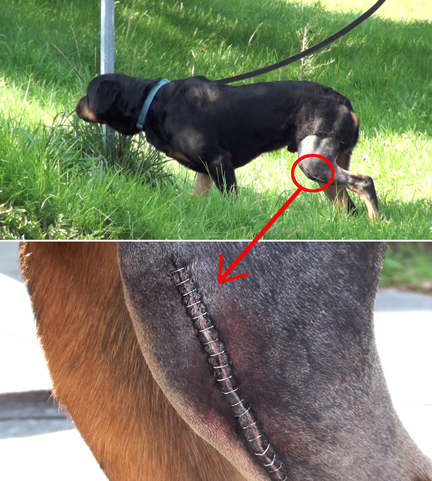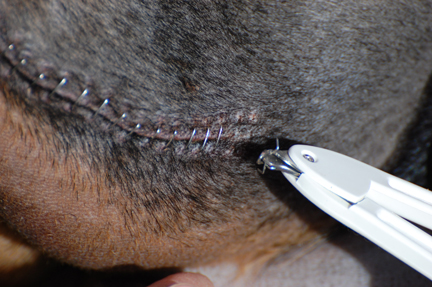Coping With Damaged Cruciates

Samson – Day after ACL Surgery
A torn anterior cruciate ligament (ACL) can be a stressful experience for dogs and owners alike. Torn ligaments are usually presented as a severe limp and an inability to bear weight on a back leg. Unfortunately for us and our rescues, it is something we have encountered far too many times.
Cruciate ligament tears can happen regardless of breed, age, or activity level. Sometimes all it takes is a slip on a smooth floor, wet grass, or ice. Even something as simple as changing direction too quickly could be enough to cause harm. That being said, the risk of tearing a ligament increases significantly in overweight or highly active dogs. The main concern, especially in overweight dogs, is that they will be forced to overcompensate on their good leg. Bearing all of their weight on the opposite leg may cause a weakening of the bone, joint or ligament, which may result in additional surgery.
To date, five of our rescues have undergone surgery to repair a torn ACL. When it comes to surgical reconstruction, there are a few options to choose from:
- use of synthetic suture material
- tibial plateau leveling osteotomy (TPLO)
- tibial tuberosity advancement (TTA)
However, depending on the age and overall health of the dog, surgery may not be an ideal solution, as was the case with Chico. If surgery is not in the dog’s best interest, there are a number of non-surgical options available that will ensure they live a happy life.

Blue – Removing Staples from Incision
If surgical repair is performed, there are many options when it comes to recovery procedures and techniques. A recovery program should be tailored to each dog’s individual needs and must take into consideration their health, energy level, and overall interest in these activities. Recovery time for this type of surgery is quite long and may require restricted exercise for up to 3 months. This does not pose a particular problem for dogs with low-moderate activity levels, as was the case with Blue. In fact, it served us well because it gave us opportunities to apply confidence building and leash skill exercises. For high energy dogs like Mia on the other hand, every day posed a new challenge. We had to get creative with ways to keep her busy in order to prevent her from channeling her energy inappropriately. The day that we could finally let her run off-leash was thoroughly enjoyed by all! With Aero, surgery was followed up with Canine Platelet Enhancement Therapy (C-PET). The procedure was performed in order to facilitate healing of the surgical leg and to minimize further damage in the other knee identified with a partial tear.
Regardless of the treatment, recovery, and maintenance program used, it is important to keep the dog’s individual circumstance and best interest in mind. We are very fortunate to have a skilled and knowledgeable veterinarian that performed each of the ACL surgeries. We are very pleased that Sox (RIP), Samson, Mia, Blue and Aero all made complete recoveries.
For more information on the symptoms & treatment of torn ACLs, check out the article on the pet education webpage.
For an overview of C-PET, check out the video on Aero’s platelet enhancement therapy.

